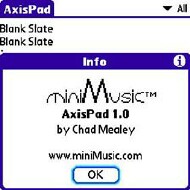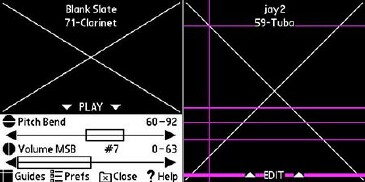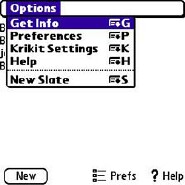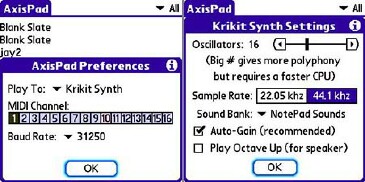
Breathe a nostalgic sigh for those old movies where the beset heroine climbs the spooky staircase unaware of lurking danger, the suspense greatly magnified by those weird, to say the least, soundtracks. Seems like Martians are landing outside, and they are. That whining glissando came from an early electronic instrument called a Theremin. Rent The Day the Earth Stood Still to refresh your memory.
Now, take out your Treo and consider it, not for playing MP3s, but for making your own synthesized music - spooky movies or no - and were not just talking fun and games. You could turn out riffs useful to serious musicians, play your Treo like a synthesizer on stage at the Roxy. Or wherever.
The trick is AxisPad, from MiniMusic. It makes your Treo into a stylus-driven synthesizer with homage to the Theremin. Instead of two heterodyne antennas (whatever those are) to control pitch and volume, you tap, drag, and point on a grid lets hear it for axes on the Treos screen.
The program goes a giant leap further, permitting output to a variety of MIDI-enabled musical instruments, including synthesizers and (gasp!) computers. With promised updates and enhancements, youll be able to store a MIDI sequence on the Treo to be moved to a computer and edited, played, or enhanced. Physical output to MIDI requires a hardware interface, of course, and the program doesnt currently store MIDI sequences.

AxisPad works in sound gestures. The two axes, up/down and left/right, control the pitch that comes out and at what volume. You can also set up the volume range and the amount and range of pitch bending that you want. A menu that pops up from the bottom of the screen (use the 5-ways Up button) lets you change the settings. The left and right buttons step through the "instruments." You can also turn on "guides," which help you decide where the pitches are. A western diatonic scale isnt really what the Theremin, or AxisPad, is about, but you can get close with the guides. Some MIDI equipment will help (or hinder) that quantization, too.
Thats pretty much it. How uncomplicated can you get?
So, what does any of this have to do with a Theremin, of Robbie the Robot fame? Plenty. AxisPad is MiniMusics update of Pete Moss Theremini/Theremidi application, one of the earliest music shareware applications for the Palm platform. AxisPad, by Chad Mealey, re-interprets Moss idea, adding support for the latest technologies, including current Treo models. It does not run on Windows Mobile 5, and the company does not (yet) support any other OS. The sequences it makes are compatible with Windows and Macintosh computers (with MIDI music software running), as well as any of the many musical instruments and paraphernalia that speak MIDI.

Of course the music comes out the Treo speaker or earphone if you choose. AxisPad uses the companys Krikit Synth sound system (whatever that is) to create the musical tones that you hear. It simulates an instrument from the companys NotePad application. These dont quite conform to the music industrys General MIDI specification. General MIDI defines "vanilla" instruments built into many MIDI-capable synthesizers things like piano, clarinet, French horn, drumkit, a variety of each. Synthesizers create their sound in different ways, but when you select a General MIDI instrument, you get the same type of sound piano, lets say no matter who made the synth.
If this is confusing to you, dont worry. You dont need any techie knowledge to play and enjoy AxisPad. Just put on your headphones, for much better sound, and jam.
MIDI explained
In case our story so far really is confusing, lets break for MIDI Music 101. Lets say you want to play a tune from a remote location. Over the phone, for example. You call someone who has a synthesizer and tell them to play a note, "E" well say, and hold that key down till you say "off." Then play "D". Hold till you say "off" and then "C", and so on. By timing your "play" and "off" commands and changing the note to be played you can, from a distance, direct a stirring performance of Three Blind Mice. Both you and the mice will get a thrill. Mozart will be jealous.
MIDI music does the same thing, fast. It operates over a serial cable special connector of course that visits computers, MIDI-enabled synths and other musical instruments in turn. You dont need a computer for this, but what are synthesizers anyway but specialized computers. With this rig, the devices can hold a conversation, one controlling others. For example, a synth can "play" other synths (plural!), and a computer can play several instruments at the same time. The only limit is your wallet.
The power of MIDI isnt so much the performance as the storage. The commands ("off" "on" "E", "D", "C"
" and a plethora of complications) that get sent down the wires to make all this happen can be recorded in a simple "sequence" file, which can be stored in MIDI instruments on tapes or CDs, or on computer disks floppy, hard drives, or whathaveyou. Computers (and many synths) can edit the sequences, play them, sweeten them with other complications, and save them as new files. Computers can score them, add harmonies, split parts for individual players, and so on.
The point of all this, relative to AxisPad on the Treo, is that while youre enjoying yourself fiddling with the Theremin-like music you make with the stylus, the Treo can record a MIDI sequence, just like that umpty-thousand-dollar synthesizer I wish someone would buy me. Indeed, AxisPad stores much more than simple note-on, note-off information. It invokes the many complications of MIDI technology to simulate phrasing and after-touch, and adjust many other performance and sound parameters. Passed along to synthesizers with the ability to interpret these subtleties, the result can be awesome.
MIDI in the Treo
Before you change it your Treos native ringtone is a MIDI sequence. So, youd think you could make a new one with AxisPad. No way. Youd also think the Treo could play back AxisPads sequences. It cant. Moved to a computer, nothing can play the programs files, either. Whats wrong with this picture? The problem is that AxisPads stored slates arent MIDI sequences. You have to add a hardware MIDI interface to the Treo and either settle for performance mode, or send to a MIDI-enabled computer and capture the sequences. I put this question to the developer and got this encouraging response:
"Although we do plan to offer save/record/export features in AxisPad, right now only the settings are saved, not the performance. A future upgrade will allow you to save performances as MIDI files or wav files which could be used as ring tones, but that didn't make it into the first release. AxisPad can send MIDI data in real time to external MIDI
hardware, but cannot yet save that data to a file."
"To use AxisPad to send MIDI data (on 700p) as you play you need a special HotSync serial cable and MIDI hardware. The 700p cannot act as a USB host, so the USB HotSync cable can't be used for MIDI connections. This is a more easily used feature on older handhelds (with the 'universal connector' or earlier)."
Theres more information about this on MiniMusics website. The programs work on a variety of PalmOS devices, but the current Treo models enable sound features that the older versions didnt have. The companys website offers advice on which hardware to choose, even used older models. Sadly, though, theres not much documentation available. You can download a free, limited-function demo of AxisPad at: ftp://www.minimusic.com/pub/minimuse/AxisDemo10.zip
Shortcomings

Intuitively easy to enjoy, AxisPad doesnt come with much of a manual, and theres no futher guidance on the companys website, where its ignored among the Frequently Asked Questions. The program could use some more-slash-better documentation, as the user is left with questions that cry for answers.
For example, there are several choices for "play to," including serial port. My Treo 700p has no serial port, but see Chads quote above for more information on this. This information, and lots more like it, ought to come with the software, or at least be available from their website.
With some of these "play to" options selected, the programs output redirects somewhere, and nothing comes out the speaker. This isnt true for the "sound card" option, however. In fact, sound card does a better job of some of the instruments than the companys much touted Krikit Synth.
Coming attractions
Last reel. Cue the Theremin player one more time and lets look into the crystal ball. MiniMusics AxisPad comes as a standalone application, or included in the companys "suites" of synthesizer-like software for the Treos: Handheld Music Suite and Pro Music Suite. Theres some redundancy among them, and the Handheld Suite
contains a new version of the cute game-like musical notation training program, Bugband.
Inspired by AxisPad, Im working on reviews of the suites, too. If only I could stop playing with the Martian Theremin-inspired music long enough to check them out.
Update: An update to AxisPad to work on the Treo 680 is now available from MiniMusic. If you downloaded the demo and trouble with it working on your shiny new 680, go
here to get the updated
version. The current version of the program, now 680-friendly, is available from the
product page.
Next Page: Conclusion >>